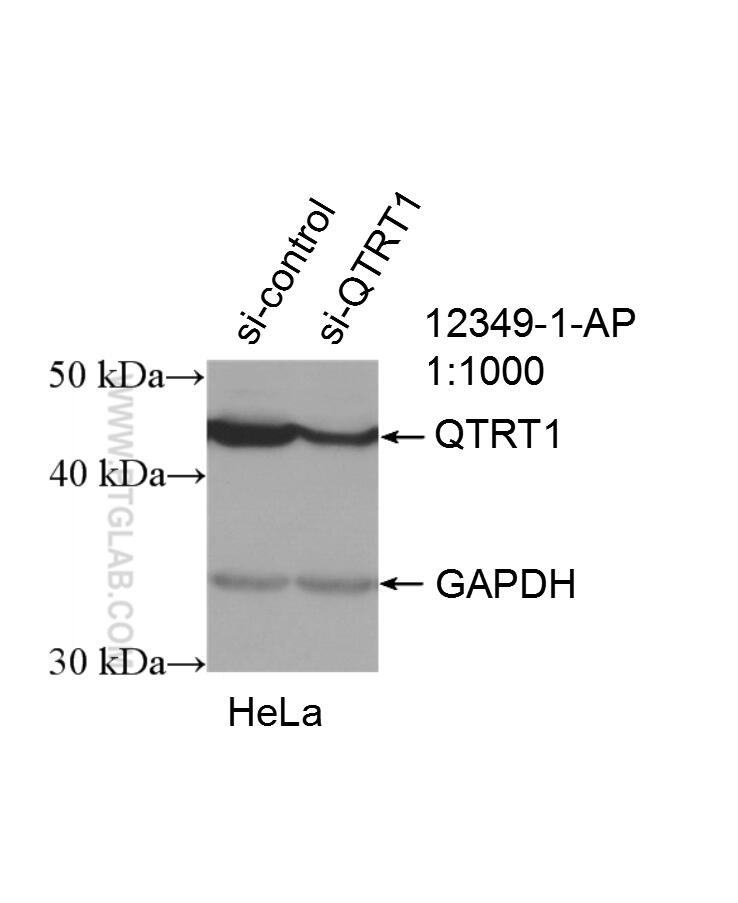验证数据展示
经过测试的应用
| Positive WB detected in | HeLa cells |
推荐稀释比
| 应用 | 推荐稀释比 |
|---|---|
| Western Blot (WB) | WB : 1:500-1:2000 |
| It is recommended that this reagent should be titrated in each testing system to obtain optimal results. | |
| Sample-dependent, Check data in validation data gallery. | |
产品信息
12349-1-AP targets QTRT1 in WB, ELISA applications and shows reactivity with human samples.
| 经测试应用 | WB, ELISA Application Description |
| 经测试反应性 | human |
| 免疫原 |
CatNo: Ag3010 Product name: Recombinant human QTRT1 protein Source: e coli.-derived, T-HIS Tag: 6*His Domain: 1-358 aa of BC015350 Sequence: MPVGTQATMKGITTEQLDALGCRICLGNTYHLGLRPGPELIQKANGLHGFMNWPHNLLTDSGGFQMVSLVSLSEVTEEGVRFRSPYDGNETLLSPEKSVQIQNALGSDIIMQLDDVVSSTVTGPRVEEAMYRSIRWLDRCIAAHQRPDKQNLFAIIQGGLDADLRATCLEEMTKRDVPGFAIGGLSGGESKSQFWRMVALSTSRLPKDKPRYLMGVGYATDLVVCVALGCDMFDCVFPTRTARFGSALVPTGNLQLRKKVFEKDFGPIDPECTCPTCQKHSRAFLHALLHSDNTAALHHLTVHNIAYQLQLMSAVRTSIVEKRFPDFVRDFMGAMYGDPTLCPTWATDALASVGITLG 种属同源性预测 |
| 宿主/亚型 | Rabbit / IgG |
| 抗体类别 | Polyclonal |
| 产品类型 | Antibody |
| 全称 | queuine tRNA-ribosyltransferase 1 |
| 别名 | EC:2.4.2.64, FP3235, Guanine insertion enzyme, Queuine tRNA-ribosyltransferase catalytic subunit 1, TGT |
| 计算分子量 | 403 aa, 44 kDa |
| 观测分子量 | 44 kDa |
| GenBank蛋白编号 | BC015350 |
| 基因名称 | QTRT1 |
| Gene ID (NCBI) | 81890 |
| RRID | AB_2877847 |
| 偶联类型 | Unconjugated |
| 形式 | Liquid |
| 纯化方式 | Antigen affinity purification |
| UNIPROT ID | Q9BXR0 |
| 储存缓冲液 | PBS with 0.02% sodium azide and 50% glycerol, pH 7.3. |
| 储存条件 | Store at -20°C. Stable for one year after shipment. Aliquoting is unnecessary for -20oC storage. |
背景介绍
QTRT1 (Queuine tRNA-ribosyltransferase catalytic subunit 1), also known as tRNA-guanine transglycosylase (TGT), is a key enzymeinvolved in the post-transcriptional modification of tRNAs. In humans, the QTRT1 and QTRT2 heterodimer complex exhibits transglycosylase activity, and replaces the guanine base of the first letter of the tRNA anticodon with q, thus forming Q on the tRNA (PMID: 30149595, 25884661). High QTRT1 expression is a biomarkerfor poor prognosis in LUAD patients, and QTRT1 mayfunction as a latent tumor biomarker in the prognosticprediction for LUAD (PMID: 33490170).
实验方案
| Product Specific Protocols | |
|---|---|
| WB protocol for QTRT1 antibody 12349-1-AP | Download protocol |
| Standard Protocols | |
|---|---|
| Click here to view our Standard Protocols |


